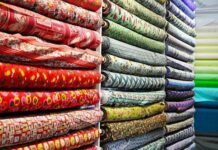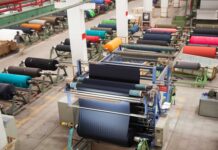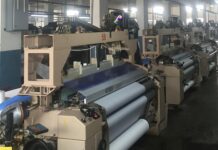Ayaz-ud Din was sitting on his pushcart of second hand garments, commonly known as ‘Landa,’ and gazing at passer-by’s. He is looking for customers like his four in-laws, who arrived in Karachi, the port city, in September to start the seasonal business of warm clothes.
They finally choose Old Sabzi Mandi, the city’s busiest artery that connects University Road and Kashmir Road, to start a new journey. In between fruit vendors, Ayaz-ud Din and his relatives placed pushcarts and loaded them with second hand warm jackets, coats, gloves and socks, but there are no buyers.
“I am afraid it may prove as a failed venture,” Ayaz-ud Din said “I along with my four relatives arrived in Karachi from Bajaur few months back to start a business, due to the deteriorating law and order situation there,” Ayaz-ud Din narrated his story.
“We purchased pushcarts and bought used warm garments from Shershah Scrap Market to start a business, but there is no winter in the city,” the disappointed vendor claimed. He explained that he has not even been able to cover the cost of the cart he purchased in October.

He explained that right now his entire family is praying for rain in Quetta as the winters there are closely linked to the climate in Karachi. “I have been observing people in this area for a month now and not one of them have worn a coat or jacket” he explained.
“Who will purchase warm clothes in a season in which people are still using fans to maintain room temperature in their homes,” he questioned. “We left our hometown for business due to lack of business-friendly environment, but we can’t find business in the financial hub of Pakistan.”
Shershah Scrap Market is the country’s biggest wholesale market for used warm clothes, but this year there has been a slowdown in activity. Despite low business activity the warehouses of used garments, spreading over thousands of acres are still full of used clothes. Masons can be seen engaged in sorting out the latest lot of used clothing for sale at the market while some of them pack the clothes deceptively to be sold at retail outlets elsewhere as new items.
There are two types of wholesalers; ones who import second hand warm clothes directly, and others who buy the used warm clothes through bidding, which usually takes place at the port after offloading.
“We import used warm garments from UK, US and Germany,” Aziz-ur Rehman, who owns a warehouse in Barkat Market inside Shershah Scrap Market claimed in an interview with Profit. Used garments are also imported from Belgium, Spain, France, Japan and China, but Pakistanis prefer imports from UK the most because of physical similarities between the British and Pakistani’s.
Second highest imports are from US. Rehman told us that a normal container of used warm clothes that lands at Karachi port, contains gloves, knit caps, monmouth caps, scarves, snowmobile suits, snowsuits, sweaters, pashminas, knitted berets, ski trousers, woollen socks and warm long boots.
The first task is to separate the imported material from the cheaper local items. After separation, the second hand clothes are further divided into categories. For instance, sweaters will be further divided into 12 more categories. The prices of these imported garments are fixed after categorization, depending upon the condition of items.
The ‘A’ category items are usually exported to Afghanistan, Tajikistan and others landlocked countries of Asia. Pakistan even exports certain items to some African countries. Locally we sell ‘C’ category items as they are the cheapest in the lot and more affordable for locals as compared to ‘A’ category items.
Rehman claimed that the importers of used warm clothes are now earning from exports rather than local sale as winters have started getting shorter and warmer the local market for used warm clothes has shrunk dramatically. “I belong to Quetta, and have been running this wholesale business for the last 18 years, but the last two years I have suffered losses” Rehman explained. The second floor of Rehman’s warehouse is packed with stock from last winter which he was unable to sell due to the short winters.

Despite reduction in demand of second hand clothes there is still some activity. Wholesalers from cooler cities with longer winters come to the market and buy in bulk. One such buyer is Muhammad Shahbaz from Muzaffarabad in Punjab who opened a shop there last year and buys second hand clothes from Shershah market.
“I earned profit last year and I came here second time this year for buying as the items which I have bought in October were sold out,” Shahbaz claimed, adding that “The weather is cold and cloudy in Muzaffarabad and if I compare the temperature of Muzaffarabad with Karachi, I can safely say it is just 20 percent of the cold which we are experiencing in Muzaffarabad.
The traders at ‘Light House’, the country’s biggest retail market of used garments, complained of low sales of warm clothes this year. Though, Lighthouse is popular for selling second hand clothes there are very few shops in the market left that deal in used clothes. Many used garment trader have started selling first hand curtains, cushions and blanket while other sell sports items and first hand sportswear.
There are still shops that display winter clothes like sweaters. Jacket and scarves but majority of the shoppers are still buying T-shirts and other summer clothes. Shopkeepers selling used winter wear at Lighthouse are now eagerly waiting for December to end and temperatures come down and their sales can go up. One such shopkeeper, Khan, explained that Karachi has had no winters for the last three years. He has therefore started selling used T-shirts during the summer in order to cover the losses of the winter season.
While second hand sellers feel the pinch of shorter winters, first hand warm clothes manufacturers and sellers are also feeling the brunt. They believe that global warming has taken a serious toll on Karachi’s winters that have become shorter and warmer resulting in little to no demand for their products.

Similar big retail outlet centres like Zainab Market for example are going through the same thing. They are also selling summer clothes, mostly T shirts due to the warm winters being experienced this year. Winter wear business is at best only 20% of the business of warm clothes at Zainab market said one shop owner.
Royal Fashions, an outlet of leather wears in the market, has been operating in Zainab market for the past 36 years. Apart from manufacturing and selling leather wear at wholesale rates through outlets in all major cities the company exports their products as well.
“If we talk about boom and bust in the leather wear business, I think the 90’s were our peak years as far as manufacturing and sales are concerned, but the business, gradually, lost attraction since last decade” the owner of Royal Fashions, Syed Asif Bukhari claimed.
The shop owner prays for a longer winter every year so that he can have a profitable year but that remains an elusive pipe dream with winters becoming shorter every year. This was clearly visible with almost no customers at his outlet during December which is supposed to be their best selling month. This year in 2016 we will be doing only about 7% of the business we did back in 1991-1992 he claimed.
He also attributed this fall in demand for his products due to cheaper products from China being sold there. Though the quality of Chinese products is comparatively low, their manufacturing is of a superior quality which is why people buy cheaper Chinese leather products as opposed to Pakistani leather wear.
The prices of leather wears increased globally, but we didn’t move an inch ahead. In 1992, we sold a leather jacket against Rs 1,275 and pay Rs 250 for its stitching. In 1992, the price of one US dollar was Rs 16, and now we are selling a leather jacket at Rs3,500 for which we pay Rs 2,000, but the price of one US dollar is 104.

Back in 1992 we sold leather jackets for Rs1,275 paying Rs250 for stitching when the price of one US dollar was Rs16. Now we are selling a jacket for Rs3,500 paying Rs2,000 for stitching and one US dollar is for Rs104. So our margins have decreased as input costs have increased due to a weaker rupee.
Bukhari has no export orders this year either and is relying mostly on overseas Pakistani’s who buy cheaper high quality products from us to take back and wear in the colder climate countries where they are settled.
“Pakistan, India and Bangladesh would continue to bear losses of global warming, which is result of the excessive use of fossil fuels for unsustainable development,” Karachi University’s Environmental Studies Assistant Professor Dr Waqar Ahmed observed. “Another reason behind increasing intensity of global warming in these countries is deforestation on massive scale on account of development,” Ahmed added.
“Forests sequester carbon dioxide from the atmosphere and transfer it into the soil, but as forests disappear carbon dioxide is reemitted into the atmosphere resulting in unusual warming,” Ahmed explained.
“Globally, efforts are being made to reduce emission of carbon dioxide and increasing forest area to deal with the issue of global warming, but in Pakistan, deforestation is going on without any check,” Ahmed noted.

Anjuman Falah Tajiran Second Hand Clothing President Hakeem Shah says one problem for us is low demand due to shorter winters as a result of global warming but the imposition of higher import duties and taxes has become another problem for us making it difficult to survive. “Few years back, we used to pay just Rs 70,000 on account of taxes for containers arriving via ship, but now we are paying millions of rupees on account of taxes. There is no tax over the import of used garments in any country, but the Pakistani government is charging tax on import of used clothes” he added.

Just a few years back around 30,000 containers of used warms clothes arrived at Karachi’s port. The number is now only 10,000. Similarly the pushcarts vendors who made up around 50% of Shershah markets used warm clothes sales came from Punjab. KP and Baluchistan and set up shop in Karachi. Now only wholesalers are coming from these provinces, buying the merchandise at wholesale prices and taking it back to their respective cities to sell there.
The business of second hand warm clothes is dying with sales dropping every year. Only about 10% of the shops in the biggest second hand retail outlets like Light house and Zainab market sell warm second hand clothes for the winters























we are the importer of Landa Garments from Europe. if any one interested (WHOLE SELLERS / IMPORTERS) in Purchasing Complete Container/Containers of Landa Garments. so feel free to contact us on following number.
03009431010
Ap ki shop kaha h
Importer of used clothes from belgium. If any one interested in purchasing complete Container at 1 – 3% (specially from Punjab , KP and Gilgit) contact without wasting time +923412135294 Shershah mein warehouse bh ha sorting kr ke wahin sa le jao.
Comments are closed.